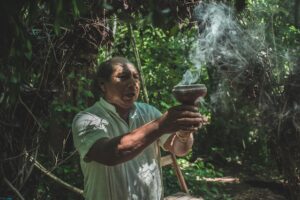
Belize is an incredible melting pot of cultures. Its varied history has had a lasting effect on the country’s many languages and traditions. Belize’s official language is English, though many citizens also speak Spanish, Maya, and Garifuna as part of its multicultural history and present-day immigration trends.
English is the Official Language
Belize’s official language is English, spoken by most as both their first and second language. Many citizens also utilize Kriol – an African-influenced Creole patois that may be hard for visitors unfamiliar with it to comprehend – which can make tourism somewhat challenging. The Kriol dialect of Belizean English is an alternative form of English that differs significantly from standard English in several ways, including its pronunciation which differs significantly, grammar differences, and vocabulary usage. According to some, Kriol English in Belize derives from colonial English spoken by slaves exposed to it and mixed with their local languages, leading them to speak choppy English that has now been labeled Caribbean patois.
Traditionally, Belizeans with higher social standing and education could easily switch between Belizean Creole and English; those from rural areas lacked this skill. English is widely utilized for education and media in Belize, making it easier for travelers to communicate with locals while supporting its economy. Many Belizeans are multi-lingual and speak a range of different languages such as Spanish or the Mayan tongue – an aspect that assists communication as part of Belizean culture. Belizeans often speak a variety of other languages in addition to English, such as Yucatec, Mopan, and Kekchi. Some also utilize an archaic Low Saxon tongue called Plautdietsch for Mennonite communication purposes.
Belize Spanish
Belize Spanish is spoken by Mestizos, Maya people, and other ethnic groups; English speakers also commonly utilize it as their common language and consider Spanish their “lingua franca”. Belizean Spanish pronunciation resembles Caribbean Spanish and Southern Spain/Canary Islands/Latin America Spanish closely, however Belizean Spanish differs slightly in adopting voiceless alveolar affricate [ts] and the cluster /l/ (originally /r/) sound for Nahuatl origin words like quetzal and tlapaleria. Belizean Spanish is distinguished by its fluid word order and use of relative pronouns within simple sentences, making the language an ideal vehicle for creating sentences containing subjects without needing special cleft structures like those found in yes/no questions.
These characteristics of Spanish are further highlighted by its use of articles and pronouns that are typically masculine or feminine, yet definite; this allows speakers to create and deconstruct numerous grammatical forms requiring interrogative, declarative, and exclamatory verb forms. At present, Belize boasts several regional dialects of Spanish that are generally distinguished by region: northern and central Spanish are spoken predominantly in the north of Belize and south of its border with Mexico, coastal Spanish is spoken along the coastline, especially on Ambergris Caye and Orange Walk; Kitchen Spanish contains elements from Kriol language.
Garifuna in Belize
Garifuna is an ethnic Caribbean group that speak a hybrid tongue that incorporates elements of both European and African traditions. Most reside in Belize; however, there are also various communities speaking their dialect in Honduras and Nicaragua. UNESCO recognized Garifuna culture as part of humanity’s Oral and Intangible Heritage in 2001, acknowledging their unique heritage despite decades of colonization and Eurocentric assimilation. The Garifuna are amazing people that have managed to keep their cultural traditions and identity through centuries of colonization and Eurocentric assimilation. Many Garifuna speak English, while some can communicate using other languages like Spanish or French – although most still prefer their native tongue. Garifuna is a dialect of Arawakan, one of several South American languages spoken by African slaves who interacted with Arawak Indians of St Vincent and the Lesser Antilles.
Garifuna refugees escaped persecution and deportation by the British in 1797 and eventually settled across Central America, including Belize, Guatemala, Honduras, and Nicaragua. Today you can still find them living throughout these Caribbean coast countries. Garifuna people not only speak their native language but have also maintained a unique blend of Afro-Caribbean customs and traditions which set them apart from other Caribbean groups. As a result, UNESCO declared them one of the “Masterpieces of Oral and Intangible Cultural Heritage of Humanity.” Garifuna music is another integral element of culture. They possess an expansive tradition in this regard and still perform it regularly in many communities worldwide. Jabbar Lambey founded and oversees the Lebeha Drumming Center in Hopkins, a small coastal town on Belize’s southern coast. Here he offers classes to local children on how to play punta drums – something he has been doing since 2002!
Maya in Belize
Belize is home to the Maya people, who have played an essential part in both its ancient history and modern-day existence. Their impact can be seen through many well-preserved Maya ruins throughout Belize – from Caracol to Xunantunich and La Milpa to Altun Ha. Today, Belize’s Maya people speak a simplified form of Yucatec Maya and constitute approximately 11 percent of its population. They live predominantly on communal land self-governed under an alcalde or village leader system and rely heavily on agriculture for survival. Early Maya records date back to around 1500 BCE; their civilization reached its pinnacle from 300 to 900 AD, during which time Mexico, Guatemala, and Honduras all witnessed Maya influence across their respective borders. Belize’s Maya people are predominantly subsistence farmers who have been adversely impacted by encroachments from non-indigenous settlers and large-scale logging and petroleum enterprises into their traditional territories. Such incursions not only threaten Maya culture and way of life but can be devastating.
Since the mid 1990s, Maya communities in Belize have been engaging in an ongoing struggle to defend their land rights and cultural resources from being compromised by non-indigenous settlement, large scale logging operations, and petroleum development on customary lands that they regard as theirs. This fight has primarily been waged against Belizean government incentives for such activity on Maya territories. In 2007, the Supreme Court of Belize ordered the government to recognize Maya land rights and demarcate and title their lands, while also refraining from any actions which would interfere with them. Unfortunately, several years later they still hadn’t complied with this ruling.
Creole
Belize, located in Central America, is home to numerous languages and cultures. Belize boasts an abundance of Creoles who descend from African slaves brought into the country during the 1700s and 1800s; these individuals hail from various African cultures such as Ashanti, Igbo, and Ga. These African slaves eventually mixed with lighter-skinned Europeans to form Belize’s diverse population with various skin tones and hair types. As a result of miscegenation, today’s Creoles are descended from various African and European cultures, setting Belize apart from other Caribbean countries. Belize is home to an almost entirely Creole population, the descendants of African slaves brought here during the 1770s as slaves and brought over for work as slaves. Over time these ancestors combined elements from African cultures with European settler cultures to forge a unique way of life here in Belize.
Creoles once comprised almost 60% of Belize’s population; however, this proportion has steadily been decreasing over time due to immigration from Central America and the emigration of many Creoles to North America. Both events contributed to its decrease.




